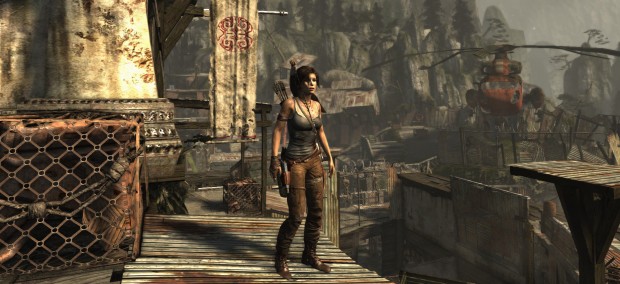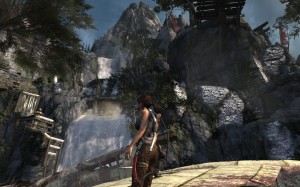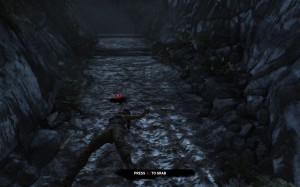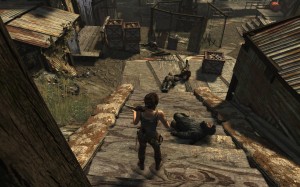Tomb Raider Review (PC)
- Updated: 2nd Apr, 2013
 I worried too much about Tomb Raider after my preview. The opening few hours do a disservice to the game a whole. It’s great. Really enjoyable, nicely paced and lots of places to explore. The balance is a bit skewed towards manshooting, as if killing people and blowing things up is the only real way for gamers to enjoy themselves but given that the puzzles themselves are somewhat lacklustre, that’s okay.
I worried too much about Tomb Raider after my preview. The opening few hours do a disservice to the game a whole. It’s great. Really enjoyable, nicely paced and lots of places to explore. The balance is a bit skewed towards manshooting, as if killing people and blowing things up is the only real way for gamers to enjoy themselves but given that the puzzles themselves are somewhat lacklustre, that’s okay.
As you may know, the new Tomb Raider is prequel and a complete reboot of the series. That means no dinosaurs, no pistols with unlimited ammo and the entire history established by the previous games is erased. Instead, Lara is a young, unseasoned explorer who gets shipwrecked on an island and does what she has to, to survive and save her friends.
In practice, that involves a lot of holding down the run button during set-pieces, with the occasional QTE. These sections look good and I guess if you want your games to look like blockbusters, they have that certain appeal. I was far more interested in the areas where you get to explore for yourself.
Exploration
These open sections are wonderful, and really show off the Lara-vs-The-Environment feel that I was missing from the preview build. You’ll be yawning your way through yet another push-forward-to-game set-piece and then stumble around a corner into a village replete with huts to climb, statues to light and twinklies to reach. There’s never really the sense of true exploration, in that you see a pathway and find something new at the end. It’s more a case of seeing a faraway statue and wondering how the hell you’re going to get up there. I love it.
In this Tomb Raider, the collectibles are woven into a wonderfully cohesive whole of the world around you. Each voice-over reveals a little more about what’s happened and why the island is how it is. You’ll even find extra insights into the relationships between Lara’s former crewmates. Rather unfortunately, if you do a lot of exploring you’ll find yourself facepalming later in the story as Lara wonders out loud about something made painfully clear in a diary that you found earlier.
 What I didn’t love, however, was the “gear gating”, limiting your equipment to prevent you from reaching certain areas. It’s not more exciting to revisit a location now that I’ve unlocked the ability to blow away barriers with a shotgun or pull down rope-covered doors with a special arrow. I’ve already found the secrets but am stymied because the designers have decided that I shouldn’t have that shiny thing just yet. How is that fun?
What I didn’t love, however, was the “gear gating”, limiting your equipment to prevent you from reaching certain areas. It’s not more exciting to revisit a location now that I’ve unlocked the ability to blow away barriers with a shotgun or pull down rope-covered doors with a special arrow. I’ve already found the secrets but am stymied because the designers have decided that I shouldn’t have that shiny thing just yet. How is that fun?
More frustratingly, when I could see collectibles I didn’t even know that I’d be able to blow away that odd-looking barricade when I unlock the shotgun two chapters later. Instead, I wasted ages shimmying around the walls, trying to squeeze in through a window or find a hole in the roof. Come on, designers. If you’re going to tease areas, tell me within the game that I don’t have the right equipment.
Preferably not in that awful, immersion-breaking “I can’t do that yet” voice-over way, though. “Maybe if I had a shotgun” would work. “Maybe if I tied a rope to an arrow, shot it into that roped bit of door and pulled it from three feet away” would also technically work, but I guess nobody wants to highlight the absurdity of that particular mechanic.
Puzzles
Adding to the disappointment, the puzzle sections were few and far between. I said in my preview that mostly, they were solved by setting fire to things. This pattern continues throughout the game. You may have read in other reviews that the puzzles are mostly confined to tombs; this isn’t really the case, and the “so-called” puzzles that you will encounter in tombs are rarely challenging. More often than not, you look around the cave for something that moves or burns and then move or burn it. Job done and “Tomb Raided” in roughly five minutes. Ten, at a push.
 The in-game puzzles are far more interesting. You’ll find yourself swinging bells around to smash obstructions or pulling levers and jumping off platforms with the right timing. These also show off Lara’s superb animation, where a perfect jump will result in a graceful landing but your crappy timing can leave her dangling backwards from a climbing axe.
The in-game puzzles are far more interesting. You’ll find yourself swinging bells around to smash obstructions or pulling levers and jumping off platforms with the right timing. These also show off Lara’s superb animation, where a perfect jump will result in a graceful landing but your crappy timing can leave her dangling backwards from a climbing axe.
The problem with the puzzles is, by making sure that all the elements to a puzzle are in the same small room, Crystal Dynamics have taken away the magic of searching for a solution. These aren’t real locations to think through and overcome. They feel like exactly what they are – a puzzle around which a single chamber has been designed. Fun, briefly engaging but ultimately unsatisfying.
Killing
Beyond the exploration and the wanton destruction of historical artifacts, Tomb Raider is a gruesome game. In the early hours of the game, Lara shoots an attacker in the face and despite her apparent reservations, goes on to shoot several hundred more, occasionally interspersed with cutscenes of her looking a bit unhappy. As the games goes on, you’ll find a good range of weapons for all occasions – the bow, a pistol, shotgun and assault rifle. Should those not be enough, there are explosives conveniently littered about the map and with enough salvage you can unlock gory executions to satisfy your blood lust.
I call it stupendous ludo-narrative dissonance, Grant calls it “a commentary on games of old“. Both views are valid interpretations borne out by the game.
 That said, Rhianna Pratchett’s response to direct questioning on the amount of killing was “We were brave in going such a long time without giving players a gun in a game where you end up doing a lot of shooting. We tried to innovate a little bit, but narrative can’t always win.” I suspect Grant’s version wasn’t an intentional part of that narrative, but he makes an interesting point.
That said, Rhianna Pratchett’s response to direct questioning on the amount of killing was “We were brave in going such a long time without giving players a gun in a game where you end up doing a lot of shooting. We tried to innovate a little bit, but narrative can’t always win.” I suspect Grant’s version wasn’t an intentional part of that narrative, but he makes an interesting point.
Multiplayer
I hated the multiplayer options. You play either the survivors, who have guns, or the Solarii, who have bows and other guns. Neither side can run particularly fast and all of them have an annoying delay on strafing or rolling. You can choose from the standard modes of Team Deathmatch, Deathmatch (Free For Fall), and Domination (Cry For Help) with the Rescue mode being a sort of asymmetrical capture-the-flag scenario. The maps can look quite nice – lots of height options, defensible bottlenecks, destructible cover and so on but it all feels so slow.
The unlocks are a complete grindfest to access new character models and weapon parts, and playing through the singleplayer adds absolutely nothing. Even after completing the game, you still need to grind from level 1 to 60 if you want to play Lara, as well as save up 10,000 salvage. More often than not, you’ll find yourself sitting there with your puny starting gun pitted against a level 37 who has already unlocked the faster reload, better aim stability and all sorts of advantages. Want to get better? Stumble around the maps long enough and eventually you’ll save up enough to buy the good stuff. Thanks, but I’ll pass.
In Summary
Tomb Raider is absolutely worth buying for the single-player alone. Some people might find joy in the multiplayer, I guess. The puzzles were somewhat lacking, but the open-world collectibles make up for the that and the game is stunningly beautiful. Yes, it’s gone a bit Uncharted-y and yes, there’s a lot of combat. Play it on easy if you have to – experiencing Lara’s story is totally worth it.
Tomb Raider is out now on PC, Xbox 360 and PlayStation 3.


Follow Us!